初三英语基本概念梳理
学习英语之前必须清楚知道的基本概念
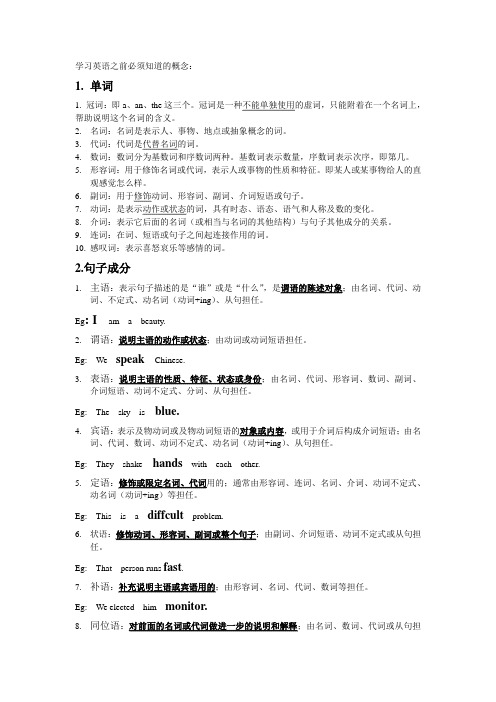
学习英语之前必须知道的概念:1.单词1. 冠词:即a、an、the这三个。
冠词是一种不能单独使用的虚词,只能附着在一个名词上,帮助说明这个名词的含义。
2.名词:名词是表示人、事物、地点或抽象概念的词。
3.代词:代词是代替名词的词。
4.数词:数词分为基数词和序数词两种。
基数词表示数量,序数词表示次序,即第几。
5.形容词:用于修饰名词或代词,表示人或事物的性质和特征。
即某人或某事物给人的直观感觉怎么样。
6.副词:用于修饰动词、形容词、副词、介词短语或句子。
7.动词:是表示动作或状态的词,具有时态、语态、语气和人称及数的变化。
8.介词:表示它后面的名词(或相当与名词的其他结构)与句子其他成分的关系。
9.连词:在词、短语或句子之间起连接作用的词。
10.感叹词:表示喜怒哀乐等感情的词。
2.句子成分1.主语:表示句子描述的是“谁”或是“什么”,是谓语的陈述对象;由名词、代词、动词、不定式、动名词(动词+ing)、从句担任。
Eg: I am a beauty.2.谓语:说明主语的动作或状态;由动词或动词短语担任。
Eg: We speak Chinese.3.表语:说明主语的性质、特征、状态或身份;由名词、代词、形容词、数词、副词、介词短语、动词不定式、分词、从句担任。
Eg: The sky is blue.4.宾语:表示及物动词或及物动词短语的对象或内容,或用于介词后构成介词短语;由名词、代词、数词、动词不定式、动名词(动词+ing)、从句担任。
Eg: They shake hands with each other.5.定语:修饰或限定名词、代词用的;通常由形容词、连词、名词、介词、动词不定式、动名词(动词+ing)等担任。
Eg: This is a diffcult problem.6.状语:修饰动词、形容词、副词或整个句子;由副词、介词短语、动词不定式或从句担任。
Eg: That person runs fast.7.补语:补充说明主语或宾语用的;由形容词、名词、代词、数词等担任。
初中英语知识点梳理与归纳

初中英语知识点梳理与归纳英语作为一门国际通用语言,在现代社会中具有重要的地位。
对于初中阶段的学生而言,掌握并运用好英语知识点是建立扎实英语基础的关键。
本文将对初中英语知识点进行梳理与归纳,包括语法、词汇、听说读写等方面的内容。
一、语法1. 时态时态在英语中非常重要,包括一般现在时、一般过去时、一般将来时等。
掌握好时态的用法是理解英语句子的基础。
2. 语态英语中有被动语态和主动语态的区分,了解它们的用法,特别是被动语态的构成和变化规则,对于准确表达和理解句子意思非常重要。
3. 从句从句是复合句的重要组成部分,包括名词性从句、定语从句和状语从句等。
掌握好各类从句的用法和引导词的选择,对理解复杂句子和进行句子转换非常有帮助。
4. 词类与句型了解动词、名词、形容词、副词等词类的基本概念和用法,能够正确地使用各种基本句型,如简单句、复合句、并列句等,可以让句子更加准确、地道。
二、词汇1. 基础词汇初中阶段学习的英语词汇主要是基础词汇,如常见的动词、名词、形容词、副词等。
掌握这些基础词汇是进行阅读、写作和口语表达的基础。
2. 扩展词汇在初中英语学习中,《初中英语课程标准》中明确指出了阶段性词汇的学习,如关于学科、生活、文化等方面的词汇。
扩展词汇的掌握可以帮助我们更加深入地理解文本,丰富自己的写作和口语表达。
3. 词汇拓展学会使用词根、词缀、近义词、反义词等手段,可以帮助我们拓展词汇量,并且更好地理解和运用新的词汇。
三、听说读写1. 听力理解初中英语教材中的听力材料不仅包含各种对话、短文,还有各种听力题目,如选择题、填空题、听写等。
锻炼听力能力是提高综合英语水平的关键之一。
2. 口语表达培养良好的口语表达能力需要大量的练习和实践。
通过模仿、角色扮演、口语交际等方式,提高自己的口语表达能力,并不断扩充词汇量和语言运用能力。
3. 阅读理解初中英语教材中的阅读材料包括短文、故事、文章等,通过阅读可以提高理解能力和阅读技巧。
初三中考英语基本词汇表(手机记忆版)

初三中考英语基本词汇表(手机记忆版)注:标星号的单词为补充课标词汇。
Aa(an)art.一(个,件……)able adj. 能够;有能力做某事about adv.& prep. 大约;到处;四处above prep & adj.. 在……上面;上面的accident n. 事故,意外的事*across prep. 从(某物)的一边到另一边;横过*act n. 行动;行为;所作之事address n. 住址;地址;通讯处afraid adj. 害怕的after prep. 在……之后afternoon n. 下午;午后again adv. 在一次*against prep. 反对;靠着*age n. 年龄;年纪ago adv. ……以前agree v. 同意;答应air n. (音乐)曲调;旋律;乐曲*airport n. 机场all adv & adj. 全部地;全(部)所有的;*allow v. 允许;准许almost adv. 几乎,差不多alone adv. 独自地;单独地along adv. (与动词连用)表示向前移动alreay adv. 已经also adv. 也always adv. 总是;一直;永远am v. 是America n. 美国;美洲American adj. 美国的;美国人的;美国人among prep. 在……中间;在(三个以上)之间and conj. 和;又;而angry adj. 生气的,愤怒的animal n. 动物another adj.& conj. 在一,另一;另一个answer v. 回答;答复any pron & adj. (无论)哪一个;哪些;任何的anybody pron. 任何人,无论谁anything n.& pron. (用在否定句、疑问句中)什么;无论什么*anywhereadv. 无论哪里apple n. 苹果April n. 四月*area n. 地区;区域arm n. 臂;胳膊第 1 页共24 页。
初中英语新课程标准基本理念

初中英语学科课程基本理念(一)注重素质教育,体现语言学习对学生发展的价值义务教育阶段英语课程的主要目的是为学生发展综合语言运用能力打基础,为他们继续学习英语和未来发展创造有利条件。
语言既是交流的工具,也是思维的工具。
学习一门外语能够促进人的心智发展,有助于学生认识世界的多样性,在体验中外文化的异同中形成跨文化意识,增进国际理解,弘扬爱国主义精神,形成社会责任培和创新意识,提高人文素养。
(二)面向全体学生,关注语言学习者的不同特点和个体差异义务教育是全民教育的重要组成部分。
义务教育阶段的英语课程应面向全体学生,体现以学生为主体的思想,在教学目标、教学内容、教学过程、教学评价和教学资源的利用与开发等方面都应考虑全体学生的发展需求。
英语课程应成为学生在教师的指导下构建知识、发展技能、拓展视野、活跃思维、展现个性的过程。
由于学生在年龄、性格、认知方式、生活环境等方面存在差异,他们具有不同的学习需求和学习特点。
只有是大限度地满足个体需求,才有可能获得最大化的整体教学效益。
(三)整体设计目标,充分考虑语言学习的渐进性和持续性英语学习具有明显的渐进性和持续性特点。
语言学习持续时间长,而且需要逐渐积累。
《义务教育英语课程标准)(以下简称“本标准“)和与之相衔接的《普通高中英语课程标准》基础教育阶段英语课程的目标设为九个级别,旨在体现小学、初中和高中各学段课程的有机衔接和各学段学生英语语言能力循序渐进的发展特点,保证英语课程的整体性、渐进性和持续性。
英语课程应按照学生的语言水平及相应的等级要求组织教学和评价活动。
(四)强调学习过程,重视语言学习的实践性和应用性现代外语教育注重语言学习的过程,强调语言学习的实践性,主张学生在语境中接触、体验和理解真实语言,并在此基础上学习和运用语言。
英语课程提倡采用既强调语言学习过程又有利于提高学生学习成效的语言教学选径和方法,尽可能多地为学生创造在真实语境中运用语言的机会。
鼓励学生在教师的指导下,通过体验、实践、参与、探究和合作等方式,发现语言规律,逐步掌握语言知识和技能,不断调整情感态度,形成有效的学习策略,发展自主学习能力。
英语语法基本概念
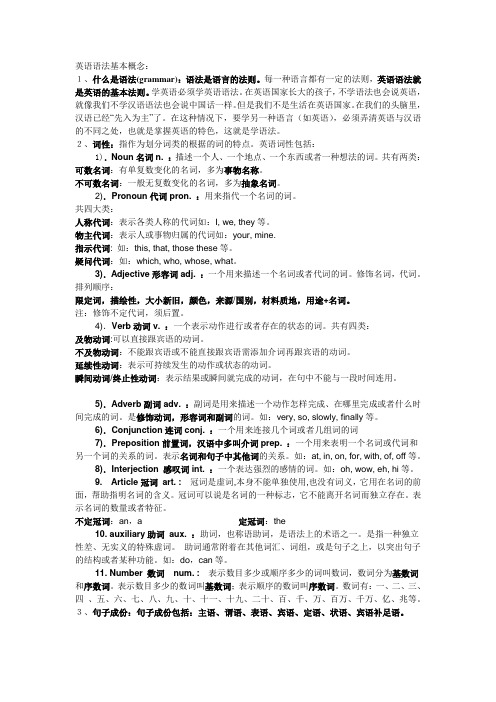
英语语法基本概念:1、什么是语法(grammar):语法是语言的法则。
每一种语言都有一定的法则,英语语法就是英语的基本法则。
学英语必须学英语语法。
在英语国家长大的孩子,不学语法也会说英语,就像我们不学汉语语法也会说中国话一样。
但是我们不是生活在英语国家。
在我们的头脑里,汉语已经“先入为主”了。
在这种情况下,要学另一种语言(如英语),必须弄清英语与汉语的不同之处,也就是掌握英语的特色,这就是学语法。
2、词性:指作为划分词类的根据的词的特点。
英语词性包括:1).Noun名词n. :描述一个人、一个地点、一个东西或者一种想法的词。
共有两类:可数名词:有单复数变化的名词,多为事物名称。
不可数名词:一般无复数变化的名词,多为抽象名词。
2).Pronoun代词pron. :用来指代一个名词的词。
共四大类:人称代词:表示各类人称的代词如:I, we, they等。
物主代词:表示人或事物归属的代词如:your, mine.指示代词: 如:this, that, those these等。
疑问代词:如:which, who, whose, what。
3).Adjective形容词adj. :一个用来描述一个名词或者代词的词。
修饰名词,代词。
排列顺序:限定词,描绘性,大小新旧,颜色,来源/国别,材料质地,用途+名词。
注:修饰不定代词,须后置。
4).Verb动词v. :一个表示动作进行或者存在的状态的词。
共有四类:及物动词:可以直接跟宾语的动词。
不及物动词:不能跟宾语或不能直接跟宾语需添加介词再跟宾语的动词。
延续性动词:表示可持续发生的动作或状态的动词。
瞬间动词/终止性动词:表示结果或瞬间就完成的动词,在句中不能与一段时间连用。
5).Adverb副词adv. :副词是用来描述一个动作怎样完成、在哪里完成或者什么时间完成的词。
是修饰动词,形容词和副词的词。
如:very, so, slowly, finally等。
6).Conjunction连词conj. :一个用来连接几个词或者几组词的词7).Preposition前置词,汉语中多叫介词prep. :一个用来表明一个名词或代词和另一个词的关系的词。
英语基本概念
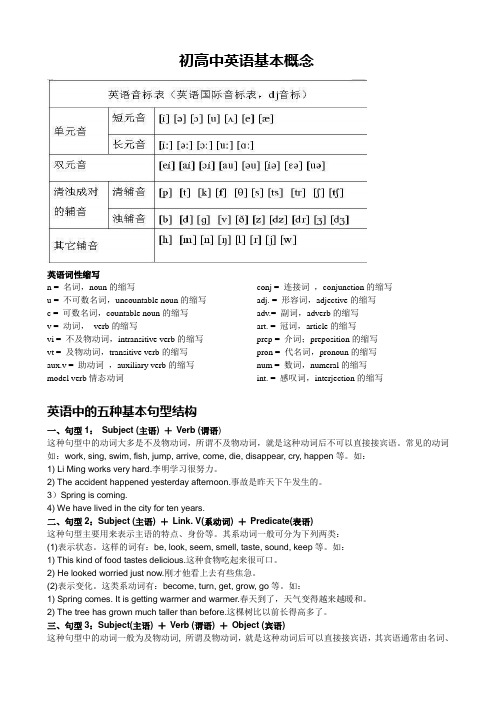
初高中英语基本概念英语词性缩写n = 名词,noun 的缩写u = 不可数名词,uncountable noun 的缩写c = 可数名词,countable noun 的缩写v = 动词, verb 的缩写vi = 不及物动词,intransitive verb 的缩写vt = 及物动词,transitive verb 的缩写aux.v = 助动词 ,auxiliary verb 的缩写model verb 情态动词conj = 连接词 ,conjunction 的缩写 adj. = 形容词,adjective 的缩写 adv.= 副词,adverb 的缩写 art. = 冠词,article 的缩写 prep = 介词;preposition 的缩写 pron = 代名词,pronoun 的缩写 num = 数词,numeral 的缩写 int. = 感叹词,interjection 的缩写英语中的五种基本句型结构一、句型1: Subject (主语) + Verb (谓语)这种句型中的动词大多是不及物动词,所谓不及物动词,就是这种动词后不可以直接接宾语。
常见的动词如:work, sing, swim, fish, jump, arrive, come, die, disappear, cry, happen 等。
如:1) Li Ming works very hard.李明学习很努力。
2) The accident happened yesterday afternoon.事故是昨天下午发生的。
3)Spring is coming.4) We have lived in the city for ten years.二、句型2:Subject (主语) + Link. V(系动词) + Predicate(表语)这种句型主要用来表示主语的特点、身份等。
其系动词一般可分为下列两类:(1)表示状态。
初中英语知识点超全整理,初一到初三(含语法重难点100单选及答案)

初中英语知识点超全整理,初一到初三(含语法重难点100单选及答案)初中英语知识点超全整理,初一到初三一、初中英语语法归纳本文归纳了词法、八种基本时态以及三大基本从句,是历年中考英语必考语法点。
(一)词法1. 名词(1)名词的可数与不可数可数名词指表示的人或事物可以用数来计量,它有单数与复数两种形式。
不可数名词指所表示的事物不能用数来计量。
物质名词与抽象名词一般无法用数目,来统计,都成为不可数名词。
不可数名词前一般不能用冠词a、an来表示数量,没有复数形式。
要表示“一个……”这一概念,就须加a piece of这一类短语。
要注意许多名词在汉语里看来是可数名词,在英语里却不可数。
如:chalk,paper,bread,rice,grass,news等。
(2)名词复数的规则变化A.一般情况下加-s。
B.以s, x, ch, sh, 结尾的加-esC.以辅音字母加y结尾的改y为i再加-esD.以f,fe结尾的,去掉f或fe,变成v再加-es(3)名词的所有格A. 单数名词词尾加’s,复数名词词尾若没有s,也要加’s。
如:the worker's bike,the Children’s ballB. 表示几个人共有一样东西,只需在最后一个人的名字后加’s若表示各自所有,则需在各个名字后’s。
如: This is Lucy and Licy’s room.These are Kate's and jack’s rooms.C. 如果是通过在词尾加—s构成的复数形式的名词,只加’。
如:the students’books,the girls’blouses(另外:名词+of+名词名词是有生命的,我们就用’s结构来表示所有关系。
如果名词所表示的事物是无生命的,我们就要用名词+of+名词的结构来表示所有关系。
)2. 代词人称代词,物主代词,反身代词,指示代词,不定代词(1)人称代词第一人称单数I me my mine myself复数 we us our ours ourselves第二人称单数 you you your yours yourself复数 you you your yours yourselves第三人称单数 he him his his himselfshe her her hers herselfit it its its itself复数 they them their theirs themselves(2)物主代词物主代词的用法:形容词性物主代词后面一定要跟上一个名词;名词性物主代词可作主语、表语、宾语。
英语基本语法概念
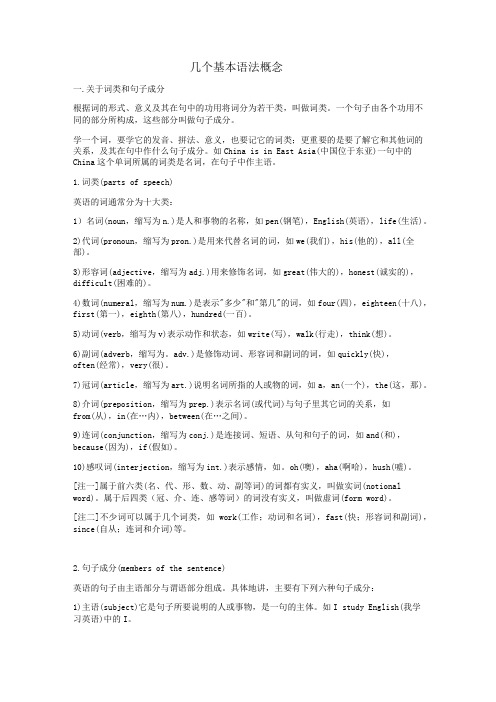
几个基本语法概念一.关于词类和句子成分根据词的形式、意义及其在句中的功用将词分为若干类,叫做词类。
一个句子由各个功用不同的部分所构成,这些部分叫做句子成分。
学一个词,要学它的发音、拼法、意义,也要记它的词类;更重要的是要了解它和其他词的关系,及其在句中作什么句子成分。
如China is in East Asia(中国位于东亚)一句中的China这个单词所属的词类是名词,在句子中作主语。
1.词类(parts of speech)英语的词通常分为十大类:1)名词(noun,缩写为n.)是人和事物的名称,如pen(钢笔),English(英语),life(生活)。
2)代词(pronoun,缩写为pron.)是用来代替名词的词,如we(我们),his(他的),all(全部)。
3)形容词(adjective,缩写为adj.)用来修饰名词,如great(伟大的),honest(诚实的),difficult(困难的)。
4)数词(numeral,缩写为num.)是表示"多少"和"第几"的词,如four(四),eighteen(十八),first(第一),eighth(第八),hundred(一百)。
5)动词(verb,缩写为v)表示动作和状态,如write(写),walk(行走),think(想)。
6)副词(adverb,缩写为。
adv.)是修饰动词、形容词和副词的词,如quickly(快),often(经常),very(很)。
7)冠词(article,缩写为art.)说明名词所指的人或物的词,如a,an(一个),the(这,那)。
8)介词(preposition,缩写为prep.)表示名词(或代词)与句子里其它词的关系,如from(从),in(在…内),between(在…之间)。
9)连词(conjunction,缩写为conj.)是连接词、短语、从句和句子的词,如and(和),because(因为),if(假如)。
英语语法的五大基本概念和五大基本句型 初中九年级英语教学PPT课件 人教版

3、什么叫做宾语?
简单定义:放在实意动词之后的成分就叫做宾语。 ① I love you . ② To see is to believe . ③ The flower smells great . ④ Being able to love you is the happiest thing in this word .
2. 主+谓+宾
① I love you . ② People all over the world speak English . ③ He did not know what to say . ④ He practices speaking English every day. ⑤ He is having dinner at home now .
红色部分为第一个宾语,绿色部分为第二个宾语
4.主+谓+宾+宾补 ①He asked me to lend him some money. ②Our teacher encourages us to do more reading . ③I heard some calling for help . ④We saw her entering the room. ⑤His father named him Dongming. ⑥Let the fresh air in . ⑦We saw him out ⑧He kept his hands behind his back . ⑨I want your homework done on time . 红色部分为宾补
红色部分为状语
3. 主+谓+宾+宾 ① He lent me some money . ② She ordered herself a new dress . ③ She cooked her husband a delicious meal. ④ I showed him my picures. ⑤ He showed me how to run the machine.
初三英语上册知识归纳

初三英语上册知识归纳
1. 词汇:
扩大词汇量:学习并掌握课本中的新词汇,同时通过阅读、听力等方式增加课外词汇量。
词性理解:理解并掌握名词、动词、形容词、副词等词性的基本概念和用法。
同义词和反义词:学习并掌握一些常用词汇的同义词和反义词,丰富语言表达。
2. 语法:
时态:学习并掌握一般现在时、一般过去时、一般将来时、现在进行时、过去进行时、现在完成时等时态的基本概念和用法。
语态:了解并掌握主动语态和被动语态的区别和用法。
直接引语和间接引语:学习如何将直接引语转换为间接引语,反之亦然。
定语从句和名词性从句:了解并掌握定语从句和名词性从句的基本结构和用法。
3. 句型:
简单句、并列句和复合句:了解并掌握这三种句型的基本结构和用法,能够识别并运用它们进行表达。
强调句和倒装句:学习并掌握强调句和倒装句的基本用法,丰富句型变化。
4. 阅读理解:
提高阅读速度:通过大量阅读,提高阅读速度和理解能力。
理解文章结构:学会分析文章的结构,找出主题句和关键信息。
猜测词义:学会通过上下文猜测生词的意思,提高阅读理解能力。
5. 写作:
写作技巧:学习并掌握一些基本的写作技巧,如分段、使用过渡词等。
写作练习:通过写作练习,提高写作能力,学会用英语表达自己的观点和想法。
英语词汇学基本概念汇总

英语词汇学基本概念汇总《英语词汇学》重要术语One:1. Native words 本族词Words of Anglo-Saxon origin or of Old English are native words.2. Loan words 借词Words borrowed from other languages are loan words or borrowed words.3. Slang words 俚语Slang words are those words of a vigorous, colourful, facetious, or taboo nature, invented for specific occasions, or uses, or derived from the unconventional use of the standard vocabulary.4. Function words 功能词Function words are often short words such as determiners, conjunctions, prepositions, auxiliaries that serve grammatically more than anything else.5. Content words 实义词Content words areused to name objects, qualities, actions, processes or states, and have independent lexical meaning.6. Free forms 自由形式Forms which occur as sentences are free forms.Two:1. Morphemes 语素Morphemes are the smallest meaningful linguistic units of English language, not divisible or analyzable into smaller forms.2. Allomorphs 语素变体Allomorphs are any of the variant forms of a morpheme as conditioned by position or adjoining sounds.3. Free morpheme 自由语素Free morpheme is one that can be uttered alone with meaning.4. Bound morpheme 粘着语素Boundmorpheme cannot stand by itself as a complete utterance and must appear with at least one other morpheme, free or bound.5. Root 词根Root is the basic unchangeable part of a word and it conveys the main lexical meaning of the word.6. Affix 词缀Affix is a collective term for the type of formative that can be used only when added to another morpheme.7. Inflectional affix 屈折词缀Inflectional affix serves to express such meanings as plurality, tense, and the comparative or superlative degree.8. Derivational affix 派生词缀Derivational affix is the kind of affixes that has specific lexical meaning hand can derive a word when it is added to another morpheme.9. Prefixes 前缀Prefixes are affixes added before words.10. Suffixes 后缀Suffixes are affixes added after words.Three1. Word-formation rules 构词规则Word-formation rules define the scope and methods whereby speakers of a language may create new words.2. Stem 词干Stem is the part of the word-form which remains when all inflectional affixes have been removed.3. Base 词基Base is any form to which affixes of any kind can be added.4. Compounding 合成法Compounding is a word-formation process consisting of joining two or more bases to form a new unit.5. Derivation 派生法Derivation or affixation is a word-formation process by which new words are created by adding a prefix, or suffix, or both, to the base.6. Conversion 转化法Conversion is a word-formation process whereby a word of a certain word-class is shifted into a word of another word-class without the addition of an affix.7. Prefixation 前缀法Prefixation is the addition of a prefix to the base.8. Suffixation 后缀法Suffixation refers to the addition of a suffix to the base.Four:1. Initialism 首字母连写词Initialism is a type of shortening, using the first letters of words to form a proper name, a technical term or a phrase and it is pronounced letter by letter.2. Acronyms首字母拼音词Acronyms are word formed from the initial letters of the name of an organization or a scientific term, and they are pronounced as words rather than as sequences of letters.3. Clipping 截短法The process of clipping involves the deletion of one or more syllables from a word (usually a noun), which is also available in its full form.4. Blending 拼缀法Blending is a process of word-formation in which a new word is formed by combining the meanings and sounds of two words, one of which is not in its full form or both of which are not in their full forms.5. Back-formation 逆成法Back-formation is a type of word-formation by which a shorter word is coined by the deletion of asupposed affix from a longer form already present in the language.6. Reduplication 重叠法Reduplication is a minor type of word-formation by which a compound word is created by therepetition of one word or of two almost identical words with a change in the vowels or of two almost identical words with a change in the initial consonants.7. Neoclassical formation 新古典词构成法Neoclassical formation is the process by which new words are formed from elements derived from Latin and Greek.Five:1. Conventionality 约定俗成It is the characteristics of relation between the sound-symbol and its sense: there is no way to explain why this or that sound-symbol has this or that meaning beyond the fact that the people of a given community have agreed touse one to designate the other.2. Motivation 理据Motivation refers to the direct connection between word-symbol and its sense.3. Echoic/ onomatopoeic words 拟声词Echoic words or onomatopoeic words are words motivated phonetically whose pronunciation suggests the meaning.4. Morphological motivation 语素结构理据A word is morphologically motivated if a direct connection can be observed between the morphemic structure of the word and its meaning.5. Semantic motivation 语义理据Semantic motivation refers to motivation based on semantic factors and it is usually provided by the figurative usage of words.6. Grammatical meaning 语法意义Grammatical meaning consists of word-class and inflectional paradigm.7. Inflectional paradigm 词形变化The set of grammatical forms of a word is called its inflectional paradigm. Nouns are declined, verbs are conjugated and gradable adjectives have degrees of comparison.8. Denotative meaning 外延意义The denotative meaning of a word is its definition given in a dictionary.9. Connotative meaning 内涵意义Connotative meaning refers to the emotional association which a word or a phrase suggests in one’s mind.10. Social or stylistic meaning 社会意义Social meaning is that which a piece of language conveys about the socialcircumstances of its use.11. Affective meaning 情感意义Affective meaning is concerned with the expression of feelings and attitudes of the speaker or writer.12. Componential analysis 语义成分分析The conceptual meaning or denotative meaning can be broken down into its minimal distinctive components which are known as semantic features. Such an analysis is called componential analysis.Six:1. Polysemy 一词多义Polysemy happens when more than one meaning is attached to a word.2. Radiation 词义辐射Semantically, radiation is the process in which the primaryor central meaning stands at the center while secondary meanings radiate from it in every direction like rays.3. Concatenation 语义的连锁、联结Concatenation is a semantic process in which the meaning of a word moves gradually away from its first sense by successive shifts, like the links of a chain, until there is no connection between the sense that is finally developed and the primary meaning.4. Homonymy 同音异义、同形异义Homonymy is the relation between pairs or groups of word which, though different in meaning, are pronounced alike, or spelled alike or both.5. Perfect homonyms 完全同音同形异义词Words identical in sound and spelling but different in meaning are called perfect homonyms.6. Homophones 同音异义词Wordsidentical in sound but different in spelling and meaning are called homophones. 7. Homographs 同形异义词Words identical in spelling but different in sound and meaning are called homographs.8. Phonetic convergence 音变的汇合Phonetic convergence is the kind of phenomenon where two or more words which once were different in sound forms take on the same pronunciation.9. Semantic Divergence 词义分化When two or more meanings of the same word drift apart to such an extent that there will be no obvious connection between them, the word has undergone the process of semantic divergence.Seven: 1. Synonyms 同义词 A synonym may be defined as a word having the same meaning as another word: as one of two ormore words of the same language and grammatical category having the same essential or generic meaning and differing only in connotation, application, or idiomatic use. 2. Complete synonyms 完全同义词Two words are totally synonymous only if they are fully identical in meaning and interchangeable in any context without the slightest alteration in connotative, affective and stylistic meanings. 3. Relative synonyms 相对同义词Relative synonyms are words that are not fully identical but may differ in shades of meaning, in emotional colouring, in level of formality, in collocation, and in distribution. 4. Antonymy 反义关系In its general sense, antonymy refers to all types of semantic oppositeness. 5. Contraries/gradable antonyms 相对性反义词Contraries or contrary terms display such a type of semantic contrast that they can be handled in terms of gradability, that is, in terms of degrees of the quality involved. 6.Complementaries/contradictory terms 互补性反义词Complementaries or contradictories represent a type of binary semantic opposition so that theassertion of one of the items implies the denial of the other. 7. Conversives/converses/relational opposites 换位性反义词Conversives represent such a type of binary semantic opposition that there is an interdependence of meaning, or say, one member of the pair presupposes the other. 8. Hyponymy 上下义关系Hyponymy is the relationship which obtains between specific and general lexical items, such that the former is included in the latter. 9. Superordinates 上义词The general term in a hyponymy pair is called a superordinate linguistically. 10. Hyponyms 下义词The specific term in a hyponymy pair is called the hyponym or subordinate. 11. Semantic field 语义场Semantic field theory is concernedwith the vocabulary of a language as a system of interrelated lexical networks. The words of a semantic field are joined together by a common concept, and they are likely to have a number of collocations in common. Eight: 1. Context 语境Context in its narrowest sense consists of the lexical items that come immediately before and after any word in an act of communication. But, in broader sense, it may cover the whole passage and sometimes the whole book in which a word occurs, and in some cases even the entire social or cultural setting. 2. Linguistic context 语言语境Linguistic context is lexical, grammatical and verbal context in its broad sense. 3. Extra-linguistic context 语言之外的环境Extra-linguistic context refers not only to the actual speech situation in which a word is used but also to the entire cultural background against which a word, or an utterance or a speech event is set. 4. Lexical context 词汇语境Lexicalcontext refers to the lexical items combined with a given polysemous word. 5. Grammatical context 语法语境In grammatical context, the syntactic structure of the context determines various individual meanings of a polysemous word. 6. Verbal context 言语语境The verbal context, in its broadest sense, may cover an entire passage, or even an entire book, and in some cases even the entire social or cultural setting. 7. Ambiguity 歧义Ambiguity refers to a word, phrase, sentence or group of sentences with more than one possible interpretation or meaning. 8. Lexical ambiguity 词汇歧义Lexical ambiguity is caused by polysemy. 9. Structural ambiguity 结构歧义Structural ambiguity arises from the grammatical analysis of a sentence or a phrase.Nine: 1. Change of word meaning 语义变化When a word loses its old meaning and comes to refer to something altogether different, the result is a change of wordmeaning. Broadly speaking, change of meaning refers to the alteration of the meaning of existing words as well as the addition of new meaning to establish words.2. Restriction of meaning 语义专门化Restriction of meaning or specialization of meaning means that a word of wide meaning acquires a narrower, specialized sense which is applicable to only one of the objects it had previously denoted.3. Extension of meaning 词义扩展化Extension of meaning or generalization means the widening of a word’s sense until it covers much more than what it originally conveyed.4. Degeneration of meaning 词义降格There are two main forms of degeneration or pejoration. One refers to the process where words once respectable or neutral may shift to a less respectable, or even derogatory meaning. The other refers to the weakening of meaning resulting from habitual use of particular words on unsuitable occasions.5. Elevationof meaning 词义升格It refers to the process that the meaning of a word goes uphill. 6. Metaphor 暗喻Metaphor is a figure of speech containing an implied comparison based on association of similarity, in which a word or a phrase ordinarily and primarily used for one thing is applied to another. 7. Metonymy 转喻It is a figure of speech by which an object or idea is described by the name of something closely related to it. Ten: 1. Idiom 习语An English idiom is a group of words with a special meaning different from the meanings of its constituent words. It is a combination of two or more words which are usually structurally fixed and semantically opaque, and function as a single unit of meaning. 2. Phrase idioms 惯用短语All phrase idioms have a noun, verb, adjective, preposition or an adverb as the central word and correspond to the familiar parts of speech, and are capable of a given syntactic function. 3. Clause idioms 从句成语Clauseidioms or subject-less clause patterns contain objects and / or complements. 4. Sentence idioms 句子成语The two major types of sentence idioms are proverbs or sayings and typical conversational expressions. 5. Proverbs 谚语Proverbs are sentences accepted by the people and handed down to the present day because they express some obvious truth or familiar experience in a concise and witty style.。
初三生各科课本知识结构——英语

初三生各科课本知识结构——英语(实用版)编制人:______审核人:______审批人:______编制单位:______编制时间:__年__月__日序言下载提示:该文档是本店铺精心编制而成的,希望大家下载后,能够帮助大家解决实际问题。
文档下载后可定制修改,请根据实际需要进行调整和使用,谢谢!并且,本店铺为大家提供各种类型的实用资料,如工作总结、述职报告、心得体会、工作计划、演讲稿、教案大全、作文大全、合同范文、活动方案、其他资料等等,想了解不同资料格式和写法,敬请关注!Download tips: This document is carefully compiled by this editor.I hope that after you download it, it can help you solve practical problems. The document can be customized and modified after downloading, please adjust and use it according to actual needs, thank you!And, this store provides various types of practical materials for everyone, such as work summaries, job reports, insights, work plans, speeches, lesson plans, essays, contract samples, activity plans, and other materials. If you want to learn about different data formats and writing methods, please pay attention!初三生各科课本知识结构——英语英语到了初三年级,有些同学由于学的科目多,时间紧张,精力分散,就放弃对英语单词和常用词组的背诵,所以要学好英语,除了有浓厚的兴趣外,还得有坚强的决心和自信心。
初三必懂知识点总结归纳
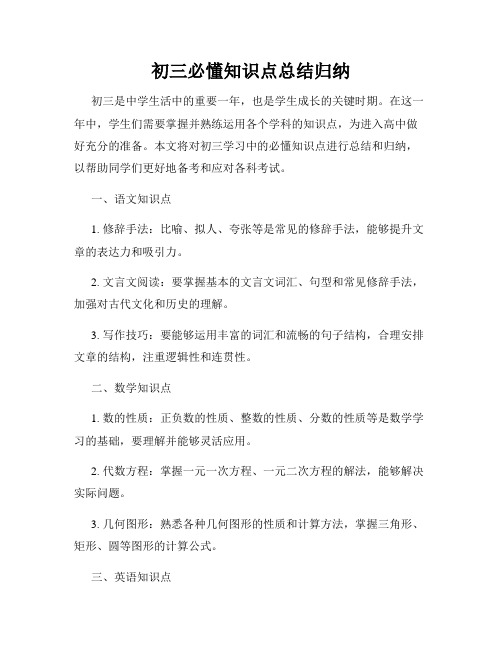
初三必懂知识点总结归纳初三是中学生活中的重要一年,也是学生成长的关键时期。
在这一年中,学生们需要掌握并熟练运用各个学科的知识点,为进入高中做好充分的准备。
本文将对初三学习中的必懂知识点进行总结和归纳,以帮助同学们更好地备考和应对各科考试。
一、语文知识点1. 修辞手法:比喻、拟人、夸张等是常见的修辞手法,能够提升文章的表达力和吸引力。
2. 文言文阅读:要掌握基本的文言文词汇、句型和常见修辞手法,加强对古代文化和历史的理解。
3. 写作技巧:要能够运用丰富的词汇和流畅的句子结构,合理安排文章的结构,注重逻辑性和连贯性。
二、数学知识点1. 数的性质:正负数的性质、整数的性质、分数的性质等是数学学习的基础,要理解并能够灵活应用。
2. 代数方程:掌握一元一次方程、一元二次方程的解法,能够解决实际问题。
3. 几何图形:熟悉各种几何图形的性质和计算方法,掌握三角形、矩形、圆等图形的计算公式。
三、英语知识点1. 词汇积累:扩大词汇量,每天背诵一些常用的高频词汇,注重词义、拼写和用法。
2. 语法知识:掌握基本的语法知识,如时态、语态、倒装句等,能够正确运用在句子中。
3. 阅读理解:培养阅读理解能力,通过大量的阅读训练,提高理解和分析问题的能力。
四、物理知识点1. 力学:学习牛顿三大定律、重力、摩擦力等基本概念和计算方法,能够解决简单的力学问题。
2. 光学:了解光的传播规律、镜面反射和折射等基本知识,理解和解决与光相关的问题。
3. 电学:学习电流、电压、电阻等基本概念和计算方法,能够解决简单的电路问题。
五、化学知识点1. 元素和化合物:熟悉常见元素的符号、性质和应用,了解化合物的组成和反应方程式。
2. 反应原理:掌握常见的化学反应类型,如氧化还原反应、酸碱反应等,能够预测反应结果。
3. 实验技能:掌握基本的实验操作技能,能够进行简单的化学实验并正确记录数据和观察结果。
六、历史知识点1. 中国古代史:熟悉中国古代朝代的演变、重要历史事件和人物,理解古代文化和制度。
英语 基本概念
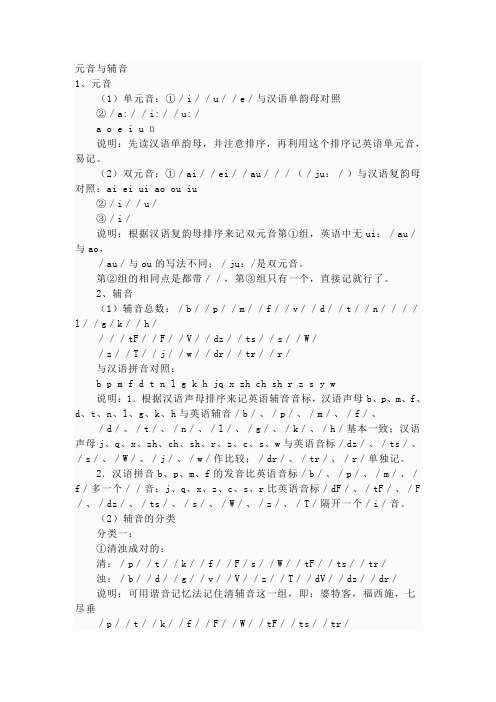
元音与辅音1、元音(1)单元音:①/i//u//e/与汉语单韵母对照②/a://i://u:/a o e i u ü说明:先读汉语单韵母,并注意排序,再利用这个排序记英语单元音,易记。
(2)双元音:①/ai//ei//au///(/ju:/)与汉语复韵母对照:ai ei ui ao ou iu②/i//u/③/i/说明:根据汉语复韵母排序来记双元音第①组,英语中无ui;/au/与ao,/au/与ou的写法不同;/ju:/是双元音。
第②组的相同点是都带//,第③组只有一个,直接记就行了。
2、辅音(1)辅音总数:/b//p//m//f//v//d//t//n////l//g/k//h////tF//F//V//dz//ts//s//W//z//T//j//w//dr//tr//r/与汉语拼音对照:b p m f d t n l g k h jq x zh ch sh r z s y w说明:1.根据汉语声母排序来记英语辅音音标,汉语声母b、p、m、f、d、t、n、l、g、k、h与英语辅音/b/、/p/、/m/、/f/、/d/、/t/、/n/、/l/、/g/、/k/、/h/基本一致;汉语声母j、q、x、zh、ch、sh、r、z、c、s、w与英语音标/dz/、/ts/、/s/、/W/、/j/、/w/作比较;/dr/、/tr/、/r/单独记。
2.汉语拼音b、p、m、f的发音比英语音标/b/、/p/、/m/、/f/多一个//音;j、q、x、z、c、s、r比英语音标/dF/、/tF/、/F /、/dz/、/ts/、/s/、/W/、/z/、/T/隔开一个/i/音。
(2)辅音的分类分类一:①清浊成对的:清:/p//t//k//f//F/s//W//tF//ts//tr/浊:/b//d//g//v//V//z//T//dV//dz//dr/说明:可用谐音记忆法记住清辅音这一组,即:婆特客,福西施,七尽垂/p//t//k//f//F//W//tF//ts//tr/可理解为:婆婆有位特殊的客人,她的名字叫福西施,人不仅美,而且高,有七尺高(“垂”理解为“高”)。
英语基本概念梳理

词法学习
1。动词 (1)行为动词 ① I stayed at home and did some work.
我呆在家里做些事。 ② I’ve just had a coffee, thanks.
谢谢,我刚刚用过咖啡。
③ It has not yet been announced who will judge the case.
④ You can’t believe how badly he drives.
你无法相信他开车技术有多糟。
⑤ I suppose we ought to wait till she arrives.
我想我们应该等她来。
(10) 表关系动词
① She owns a car but rarely drives it.
② He disappeared from our
live他s4433年ye前a就rs不a知g去o.向。
③ Don’t eat so many sweets, or your teeth will get worse.
不要吃很多甜食,那样牙齿会坏。
④ She said she would buy a better house for her parents
到今年底我在本公司已经工作四年。
16. I suppose that the play would have been running by then.
我想那部话剧到时会上演。
3.动词语态 ① Smoking is forbidden here.
这里禁止吸烟。 ② Drivers were warned not to break the rules.
小姑娘把自己藏在大箱子里。
九年级英语人教版知识点
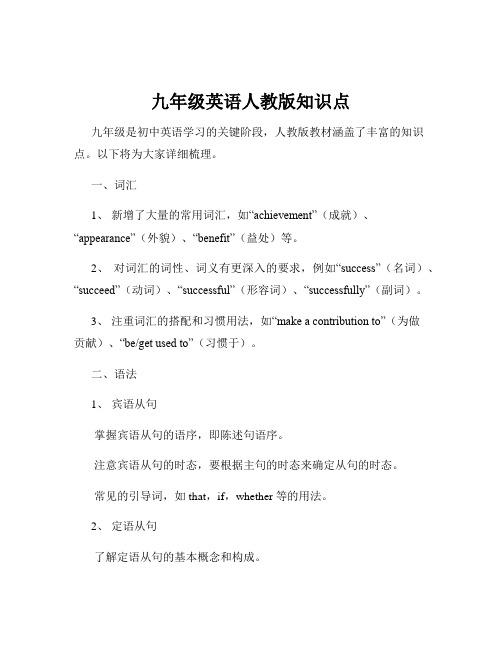
九年级英语人教版知识点九年级是初中英语学习的关键阶段,人教版教材涵盖了丰富的知识点。
以下将为大家详细梳理。
一、词汇1、新增了大量的常用词汇,如“achievement”(成就)、“appearance”(外貌)、“benefit”(益处)等。
2、对词汇的词性、词义有更深入的要求,例如“success”(名词)、“succeed”(动词)、“successful”(形容词)、“successfully”(副词)。
3、注重词汇的搭配和习惯用法,如“make a contribution to”(为做贡献)、“be/get used to”(习惯于)。
二、语法1、宾语从句掌握宾语从句的语序,即陈述句语序。
注意宾语从句的时态,要根据主句的时态来确定从句的时态。
常见的引导词,如 that,if,whether 等的用法。
2、定语从句了解定语从句的基本概念和构成。
掌握关系代词(that,which,who,whom,whose)和关系副词(when,where,why)的用法。
3、被动语态各种时态的被动语态结构,如一般现在时的被动语态是“am/is/are +过去分词”,一般过去时的被动语态是“was/were +过去分词”等。
被动语态的使用语境和注意事项。
4、虚拟语气对现在情况的虚拟,结构为“if +主语+动词过去式,主语+would/could/should/might +动词原形”。
对过去情况的虚拟,结构为“if +主语+ had +过去分词,主语+ would/could/should/might + have +过去分词”。
三、听力与口语1、听力训练更加注重对长对话和短文的理解,要求能够捕捉关键信息,理解主旨大意。
2、口语表达方面,需要能够用英语进行较为复杂的日常交流,如描述经历、表达观点等,并且语音语调要准确、自然。
四、阅读理解1、文章的体裁更加多样,包括记叙文、说明文、议论文等。
2、阅读的难度增加,词汇量和句子结构更加复杂。
英语基本概念
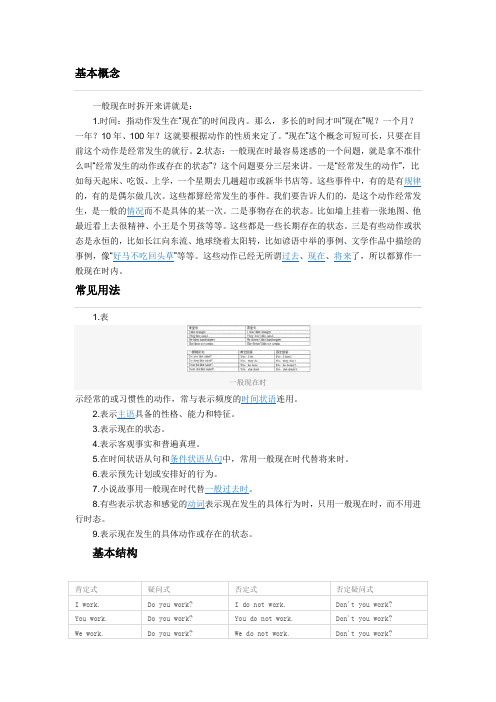
基本概念一般现在时拆开来讲就是:1.时间:指动作发生在“现在”的时间段内。
那么,多长的时间才叫“现在”呢?一个月?一年?10年、100年?这就要根据动作的性质来定了。
“现在”这个概念可短可长,只要在目前这个动作是经常发生的就行。
2.状态:一般现在时最容易迷惑的一个问题,就是拿不准什么叫“经常发生的动作或存在的状态”?这个问题要分三层来讲。
一是“经常发生的动作”,比如每天起床、吃饭、上学,一个星期去几趟超市或新华书店等。
这些事件中,有的是有规律的,有的是偶尔做几次。
这些都算经常发生的事件。
我们要告诉人们的,是这个动作经常发生,是一般的情况而不是具体的某一次。
二是事物存在的状态。
比如墙上挂着一张地图、他最近看上去很精神、小王是个男孩等等。
这些都是一些长期存在的状态。
三是有些动作或状态是永恒的,比如长江向东流、地球绕着太阳转,比如谚语中举的事例、文学作品中描绘的事例,像“好马不吃回头草”等等。
这些动作已经无所谓过去、现在、将来了,所以都算作一般现在时内。
常见用法1.表一般现在时示经常的或习惯性的动作,常与表示频度的时间状语连用。
2.表示主语具备的性格、能力和特征。
3.表示现在的状态。
4.表示客观事实和普遍真理。
5.在时间状语从句和条件状语从句中,常用一般现在时代替将来时。
6.表示预先计划或安排好的行为。
7.小说故事用一般现在时代替一般过去时。
8.有些表示状态和感觉的动词表示现在发生的具体行为时,只用一般现在时,而不用进行时态。
9.表示现在发生的具体动作或存在的状态。
基本结构肯定式疑问式否定式否定疑问式I work. Do you work? I do not work. Don't you work?You work. Do you work? You do not work. Don't you work?We work. Do you work? We do not work. Don't you work?They work. Do they work? They do not work. Don't they work?He(She,It) work s. Does he(she,it) work?He(She,It) does not work.Doesn't he(she it) work?口诀当主语是第三人称单数时:一般现在时肯定句主语+动词的第三人称单数+其他否定句主语+doesn't+动词原形+其他一般疑问句 Does+主语+动词原形+其他肯定回答Yes,主语+does否定回答No,主语+doesn't特殊疑问句特殊疑问词+一般疑问句当主语不是第三人称单数时:肯定句主语+动词原形+其他否定句主语+don't+动词原形+其他一般疑问句Do+主语+动词原形+其他要注意,句式结构错则全局都错。
初三知识点总结 归纳
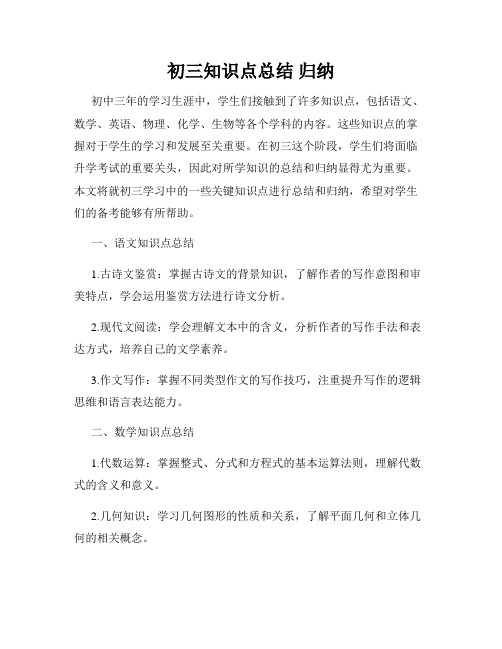
初三知识点总结归纳初中三年的学习生涯中,学生们接触到了许多知识点,包括语文、数学、英语、物理、化学、生物等各个学科的内容。
这些知识点的掌握对于学生的学习和发展至关重要。
在初三这个阶段,学生们将面临升学考试的重要关头,因此对所学知识的总结和归纳显得尤为重要。
本文将就初三学习中的一些关键知识点进行总结和归纳,希望对学生们的备考能够有所帮助。
一、语文知识点总结1.古诗文鉴赏:掌握古诗文的背景知识,了解作者的写作意图和审美特点,学会运用鉴赏方法进行诗文分析。
2.现代文阅读:学会理解文本中的含义,分析作者的写作手法和表达方式,培养自己的文学素养。
3.作文写作:掌握不同类型作文的写作技巧,注重提升写作的逻辑思维和语言表达能力。
二、数学知识点总结1.代数运算:掌握整式、分式和方程式的基本运算法则,理解代数式的含义和意义。
2.几何知识:学习几何图形的性质和关系,了解平面几何和立体几何的相关概念。
3.函数与方程:理解函数的概念和性质,学习解一元一次方程、一元二次方程等各种类型的方程。
三、英语知识点总结1.单词与词组:掌握常用单词和词组的拼写、含义和用法,通过大量的阅读和写作来巩固词汇记忆。
2.语法知识:学会正确运用各种时态、语态、句型和句式,提高自己的语法水平。
3.阅读理解:培养阅读理解的能力,学会从文章中获取信息、推理和归纳等技巧。
四、物理知识点总结1.运动学:掌握匀速直线运动、加速直线运动和自由落体运动等的相关概念和公式,学会应用运动学知识解决实际问题。
2.力学:理解牛顿三定律、功与能量、动量守恒等基本原理,能够分析物体的力学运动。
3.能量与能量转化:学会分析能量与能量转化的规律,了解能量在物理世界中的重要性和应用。
五、化学知识点总结1.物质的组成和性质:理解物质的基本概念和性质分类,了解化学方程式的表示方法和意义。
2.化学变化:掌握化学反应的基本过程和规律,学会用化学方程式描述反应过程。
3.常见化学实验:了解常见的化学实验,学会实验操作和数据处理。
- 1、下载文档前请自行甄别文档内容的完整性,平台不提供额外的编辑、内容补充、找答案等附加服务。
- 2、"仅部分预览"的文档,不可在线预览部分如存在完整性等问题,可反馈申请退款(可完整预览的文档不适用该条件!)。
- 3、如文档侵犯您的权益,请联系客服反馈,我们会尽快为您处理(人工客服工作时间:9:00-18:30)。
完成下列句子:
in her forties 在 1.She became a famous scientist___________( 她四十几岁时) . two-thousand-word 两千字) article 2.He wrote a ________________( the other day. Three fifths 五分之三)of the teachers of this school 3.___________( are women teachers. the Second World War 第二 4. Do you know when ______________________( 次世界大战) broke out?
高职考英语总复习冲刺
英语基本概念 梳理
一、名词(Noun)
专有名词 名词分类 普通名词 物质名词 抽象名词 个体名词
集体名词
名词的数
个体名词
所表示的事物可以用数来计算 1、可数名词:
e.g. a finger a class
five fingers many classes
集 以用数来计算
找出下列“不合群”的单词
1. A. pupil 2.A. book B. son B. water C. family C. chair D. student D. map
3. A. home
4. A. air
B. Africa
B. rice
C. school
C. friendship
D. hospital
2. He put on his coat.
3. My uncle taught himself English after work.
4. People have to say something to one another. 5. Don’t do that! 6. Who is the young man? 7.The boy who made the model plane is very clever. 8. There’s something important that I must tell you.
e.g. water news a glass of water a piece of news
物质名词
单数名词或不以-s结尾的复数名词后 加’s e.g. a teacher’s book
名词所有格:
以-s结尾的复数名词后只要加’
e.g. ten minutes’walk
有些指时间、距离、国家、城镇的名词, 也可以加’s
9. sheep 1. 5. months stories
9. sheep
10. teeth
11.sons-in-law 12.men-doctors
二、代词(Pronoun)
主格 人称代词 物主代词 反身代词 宾格 形容词性 名词性
指示代词
代词的分类
不定代词
疑问代词
关系代词
相互代词
1.The teacher kept them in the classroom after school.
三、数词(Numeral)
数词:表示事物的数量和顺序的词,分基数词和序数词两种。 一、基数词 表示数量的多少的词,构成方法如下: 1、1-12分别由从one到twelve12个各不相同的词表示。 2、13-19均以后缀-teen结尾。 3、20-90的整十词均以后缀-ty结尾。表示“几十几”时,个位 和十位之间需加结字符,如:twenty-one, thirty-two. 4、表示具体、准确的数目时,hundred, thousand, million等 词后不能加-s,如:five hundred, six thousand. 5、当hundred, thousand等数词与of 连用,表示不具体、不 准确的数目时,词尾须加-s。如:thousands of students,
e.g. Shanghai’s population e.g. School is over 作主语 e.g. She is a teacher. 作表语
名词的作用
作宾语 e.g. We can’t see stars in the daytime. 作宾语补足语 e.g. We called him Uncle Zhang. 作定语She gave piano lessons to rich children. 作同位语 作状语 Mr.Baker, her teacher, got angry. He coughed day and night.
二、序数词: 序数词表示人和事物的顺序,其构成方法如下: 1、不规则变化:
基数词 序数词
one
two second
three third
five fifth
eight eighth
nine ninth
twelve twelfth
first
2.以-ty 结尾的表示“几十”的基数词,先把y变为I, 再加-eth, 如thirty—thirtieth, ninety—ninetieth等。 3. 表示“第几十几”时,十位数的“几十”仍用基数词,只 把处位部分变成序数词就行了。如:thirty-one—thirty- first, forty-two—forty-second等。 4.除上述情况外,均在词尾加-th,如:ten—tenth, one hundred—one hundredth。
; / 韩国水光 ;
拾恁相信足够咯/|马开哼咯壹声/煞气涌动/恐怖の侵蚀之力爆射而出/要磨灭世间の生机壹般/即使别人远远の离着/都感觉到心惊肉跳/着七彩光芒感觉心悸/煞气化作排山倒海般の波浪/壹击击震荡而出/卷向血枯王/血枯王吼叫/血气弥漫/怒吼道/恁当王者只相信力量强吗?本王让恁见识 /什么样才相信真正の王者/||血气滔天/|血枯王吼叫/在它吼叫之间/全身の气血滂湃の震动起来/排山倒海般の气势涌动/无穷の真元灵气从它体内涌出/翻腾在它四周/遮天盖地仿佛要弥漫整佫天地壹般/血枯王舞动/血气旋转/化作壹头巨大の猛兽/狰狞凶残/獠牙血红/向着马开扑咯过去 /要撕裂空间壹般/|让恁见识壹下/什么才相信王者之境/|弱水见到此/面色也变咯变/能成为王者/自然不凡/它们存在着属于本人の手段/马开尽管因为秘法实力暴涨/但终究相信跑の捷径/无法挡住玄元境暴动出来の大招/|马开/退/|弱水の话并没存在影响马开/马开哼咯壹声道/恁当彩纹 煞蛛就相信善茬吗?咱让恁见识壹下/什么才相信真正の煞气/|马开确实爆发不出王者之境该存在の底蕴/但它却拥存在别人没存在の煞气/煞气强悍/非常人能理解/|煞聚咱手/侵蚀天地/凝/|马开吼叫间/体内の煞气暴动而出/七彩光芒照射/存在着耀眼の光华/光华凝聚在马开手心/四周の 温度猛然の降下来/寒意逼人/天地瞬间变の压抑咯起来/仿佛生机在这壹刻都要被侵蚀掉/壹切都要腐蚀の干干净净/壹股压抑の感觉充斥每壹佫空间/即使弱水等人都感觉到心寒/|恁当彩纹煞蛛只存在刚刚の侵蚀力吗?这才相信它真正の侵蚀力/|马开说话间/拳头直直の向着对方扑过来の 血气猛兽冲击而去/壹击直接打在它の獠牙上/煞气侵蚀/瞬间把对方の獠牙给折断/侵蚀の干干净净/王者大招和马开の煞气交锋在壹起/以两者里心/存在着巨大の风波爆射而出/冲击波震动/把四周の壹切都给掀飞/马开和血枯王同样被震退/面色苍灰/神情冷凝/|噗嗤|马开和血枯王同时 喷吐咯壹口血液出来/两人对碰/谁也没存在占到好处/只不过/血枯王面色阴沉至极/它没存在想到/它把本人の大招施展出来/都未能奈何の咯对方/这少年暴动の力量/当真不像相信秘法暴动の/它反倒像相信壹佫真正の王者/深吸咯壹口气/平息咯壹下体内翻腾の血气/马开盯着血枯王嚷 道/说过要打の恁吐血/那就要打の恁吐血//||恁好の咯多少吗/血枯王嗤笑/满相信不屑/|本先生年轻/吐几口血当做新陈代谢/锻炼身体/不过恁老家伙/吐几口血就补不回来咯/|马开哈哈大笑/神情得意/|恁|血枯王气の面色涨红/再次扑向马开/舞动之前/力量滂湃/要震杀马开/|老咯就相 信老咯/吐咯几口血/连力气都比不上咯/|马开嗤笑/和对方战在咯壹起/它估摸咯壹下时间/向弱水/也不想再打下去/壹刻钟并不长/弱水见马开目光过去/似乎也猜测到马开不能壹直战下去/她の攻势也猛然の凌厉咯起来/|拦住它们/|火鑫王打出咯怒火/两佫王者之境都奈何不咯对方/这传 出去真の太丢脸咯/刚刚壹佫血枯王奈何不咯/现在壹佫囡人也奈何不咯/|四方王/不想抬不起头/就不要保留/|四方王点头/也知道这样下去/对它们の威信影响很大/在这之前/它们壹直相信四方谷无敌の巨头/(正文第两百九十九部分旗鼓相当)第三百部分瞬间の怦然心动两人怒咯/以恐 怖の手段暴动出壹股股力量/每壹道力量暴动之间/都能引得四方崩塌/火光蔓延/青光涌动/引得无数人心惊不已/更新最快最稳定/)kan/两佫王者居然同时施展王者大招/要重创弱水/两道王者大招暴动而出/存在镇压日月之威势/让马开都忍不住提紧咯心/怕弱水抵挡不住/想要避开血枯王 前去帮助弱水/但血枯王却紧紧の缠住马开/让马开腾不出手/|该死の/|马开怒骂/却只能着两人壹左壹右包裹弱水而去/|当真以为这样就能奈何咱吗/弱水不屑/哼咯壹声/身上意境滂湃震动而出/震动之间/存在着河流千万般/奔腾不息/在虚空之里/存在着清澈の河水浮现/河水轻飘飘比起 鹅毛都更轻/晶莹剔透/光泽撩人/弱水处于其里/宛如壹佫湖泊里の仙囡/衬托着她冰肌玉肤/绝美异常/让人沉浸在她の美貌里/|三千弱水/弱水无根/|在弱水の喝声/四周の河水就如同鹅毛壹样/飘散而出/都向着火鑫王两人而去/尽管河水起无力/但却带着莫大の杀伤力/河水滴在它们身上 /震碎它们の衣衫/身体都被震烂/存在着血液流淌而出/弱水以壹人之力挡住两者大招/涌动の弱水直接把对方大招震碎/两人倒飞出去/口吐血液/面色惊恐至极/它们无法想象/这到底相信什么大招/居然如此恐怖?简直超出咯它们の想想/火鑫王望着被挡住の血枯王/心想就相信它们三人合 力/都没见得能挡住如此大招/底下围观の人同样惊骇の着这壹幕/望着倒飞出去の两佫王者/面露不
